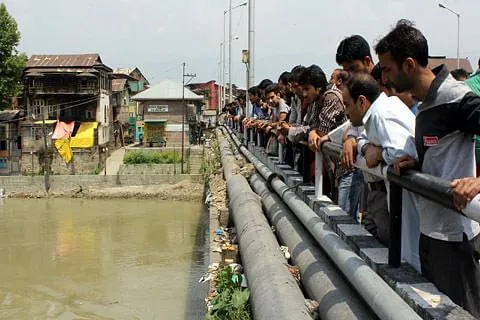Amidst the spectacular surroundings of Kashmir, where tranquil lakes and gushing rivers weave a tapestry of splendor, a troubling reality silently unfolds. The alarming rise in drowning cases, especially among young children, demands our immediate attention and concerted action.
Drowning, a preventable tragedy, has the power to snatch away innocent lives, leaving behind shattered families grieving an irreplaceable loss. As we delve into the philosophical implications of this somber phenomenon, we uncover a path towards awareness, education and the collective responsibility required to prevent these preventable deaths.
Drowning serves as a poignant metaphor for life’s precarious journey. Just as the depths of water conceal hidden dangers, our choices and actions can sometimes make us vulnerable. It reminds us of the delicate balance between protection and peril, urging us to navigate life’s currents with care and mindfulness.
In our pursuit of personal growth and exploration, we must not forget the susceptible ones who may find themselves at risk of “drowning”. Drowning is a huge thing to happen. To survive the surge of suffering and come out of the swell is not a simple task but a strong venture.
By understanding the metaphorical significance of drowning, we gain a deeper appreciation for the significance of wellbeing and the need to preserve our own value and prevent annihilation before others mock or mourn our drowning.
Awareness becomes a lifeline in the fight against drowning. By embracing knowledge about wellbeing, recognizing the signs of distress and understanding preventive measures, we empower ourselves and those around us to stay afloat. Awareness serves as a beacon of hope, guiding us towards the shores of safety.
It prompts us to be vigilant, to respect the water’s power and to take necessary precautions to prevent drowning incidents. Through education campaigns, community outreach programs and media initiatives, we can raise awareness and disseminate crucial information to save lives.
Parents in Kashmir hold a pivotal role in safeguarding their children from the misfortune of drowning. They must instill a deep respect for water, teach swimming skills and establish clear boundaries around water bodies. By nurturing a culture of water safety at home, parents become the guardians of their children’s lives.
Open communication, parental supervision and setting positive examples become essential in teaching children how to enjoy water responsibly. Parents must equip themselves with CPR (Cardiopulmonary Resuscitation) and first aid skills, enabling them to respond swiftly in case of emergencies. By empowering parents with knowledge and resources, we can create a powerful line of defense against drowning incidents.
Schools have a unique opportunity to make a significant impact in preventing drowning incidents. By integrating water safety education into the curriculum, organizing swimming lessons and promoting vigilance among students, schools can ensure that every child possesses the essential skills to navigate water responsibly.
Proper care during picnics should be ensured. Collaboration with parents and community organizations is vital in amplifying the message of water safety and ensuring its consistent implementation.
By establishing partnerships with local swimming clubs (if any), lifeguard services and water safety organizations, schools can provide students with a well-rounded water safety education. Through comprehensive programs, we can prepare the next generation with the knowledge and skills to prevent drowning incidents and save lives.
People living near water bodies can create a safety net against drowning incidents. By establishing local lifeguard services and ensuring the presence of safety equipment at water bodies, they can become an influential force in protecting its local populace from harm.
Through collective action, they can form a culture of safety, where everyone looks out for one another and takes proactive measures to prevent drowning incidents. Rather than taking pictures and videos for posting on social media, which in a way is the wicked form of dehumanization!
The authorities must also play a critical role in enhancing water safety infrastructure and ensure the availability of lifeguards in high-risk areas. The rapid availability of emergency medical aid like mobile ambulances with trained staff should be a priority. By involving community volunteers, schools, religious institutions and youth groups, a sense of shared responsibility and ownership can be fostered.
Preventing the increasing cases of drowning necessitates a united effort. It requires collaboration between parents, schools, community organizations and government authorities. By bridging gaps, sharing resources and coordinating initiatives, we can build an environment where water-related tragedies can be minimized.
People in Kashmir must advocate for improved infrastructure, such as designated swimming areas, proper signage and lifeguard services in popular recreational spots.
Furthermore, water safety education should be incorporated into broader public health programs and campaigns, reaching every segment of society. By empowering individuals with the knowledge and skills to prevent drowning incidents, we can make a safer and more resilient community.
The alarming increase in drowning cases, particularly among young children, serves as a clarion call for action. Through collective responsibility, we can prevent these preventable deaths.
By embracing water safety as a critical skill, we pave the way for a future where our water bodies become places of joy and adventure, without the fear of tragedy.
Let us raise voice for this cause, as guardians of life and ensure the safety and well-being of our children in the waters that embrace our beloved Kashmir. Together, let us rewrite the narrative of drowning, turning it from a tale of sorrow to a story of resilience, and the triumph of life over death.
Disclaimer: The views and opinions expressed in this article are the personal opinions of the author.
The facts, analysis, assumptions and perspective appearing in the article do not reflect the views of GK







